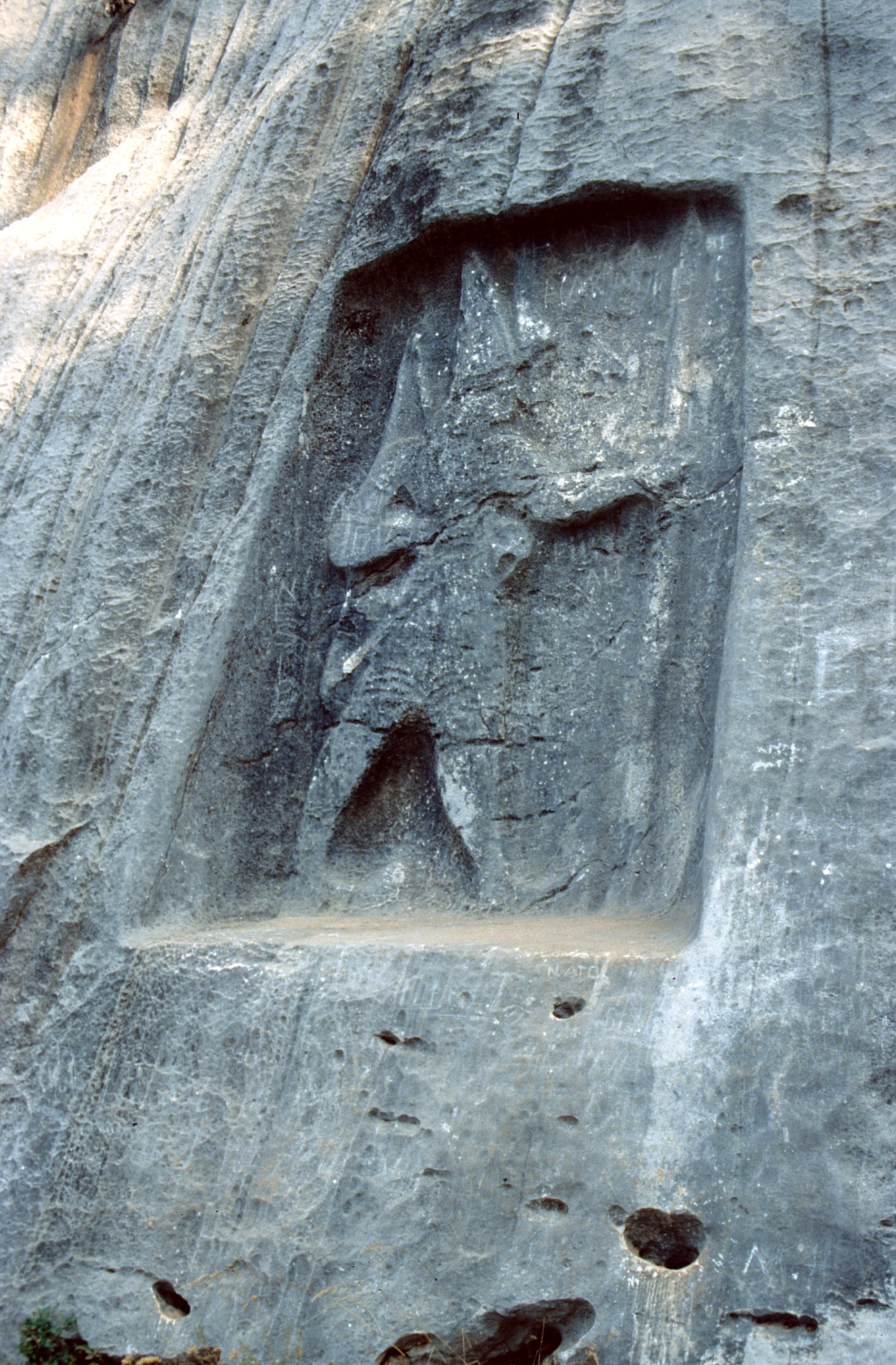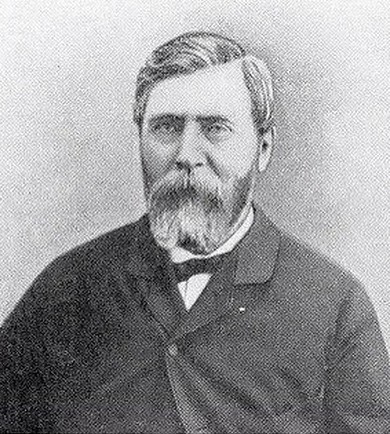|
Karabel Relief
The Hittites, Hittite / Luwian Karabel relief is a rock relief in the pass of the same name, between Torbalı and Kemalpaşa, about 20 km from İzmir in Turkey. Rock reliefs are a prominent aspect of Hittite art. Description The monument originally consisted of four parts: two ruler figures carved into the cliff (Karabel A and B) and two inscriptions on boulders (Karabel C1 and C2). During the construction of a road through the pass between 1977 and 1982, all the reliefs except for Karabel A were destroyed. Karabel A shows a warrior marching to the right with a bow in his right hand and a spear in his left. There are Luwian hieroglyphs inscribed above his left arm. The relief is 1.5 m wide and 2.5 m high The Karabel relief was damaged by unknown persons, presumed to be treasure hunters, in early 2019. Research history Herodotus interpreted the figure as the Egyptian Pharaoh Sesostris. The relief was visited by the French traveller Charles Texier in 1839 – he publi ... [...More Info...] [...Related Items...] OR: [Wikipedia] [Google] [Baidu] |
Charles Texier
Félix Marie Charles Texier (22 August 1802, Versailles – 1 July 1871, Paris) was a French historian, architect and archaeologist. Texier published a number of significant works involving personal travels throughout Asia Minor and the Middle East. These books included descriptions and maps of ancient sites, reports of regional geography and geology, descriptions of art works and architecture, et al. Trained as an architect at the École des Beaux-Arts in Paris, he was appointed inspector of public works in 1827. He conducted excavations of the port cities of Fréjus and Ostia.Prosopo Sociétés savantes de France In 1833 he was sent on an exploratory mission to , where, in 1834, he discovered the ruins of the ancient [...More Info...] [...Related Items...] OR: [Wikipedia] [Google] [Baidu] |
Seha River Land
The Seha River Land was a kingdom in Western Anatolia Anatolia (), also known as Asia Minor, is a peninsula in West Asia that makes up the majority of the land area of Turkey. It is the westernmost protrusion of Asia and is geographically bounded by the Mediterranean Sea to the south, the Aegean ... in the Late Bronze Age known from Hittite texts. Part of Arzawa, it was located north of Kingdom of Mira, Mira and south of Wilusa, and at one point controlled the island of Lesbos, Lazpa. History The Seha River Land was a reluctant vassal state of the Hittite Empire, and much of its known history was turbulent. The ''Annals of Mursili II'' recount how the Hittite king Mursili II consolidated power over the region around 1320 BC, crushing a revolt in which the Seha River Land participated. According to Mursili, he besieged the Seha River Land's capital and was on the verge of destroying it when he accepted a last minute mercy plea from Manapa-Tarhunta, King Manapa-Tarhunta's ... [...More Info...] [...Related Items...] OR: [Wikipedia] [Google] [Baidu] |
John David Hawkins
John is a common English name and surname: * John (given name) * John (surname) John may also refer to: New Testament Works * Gospel of John, a title often shortened to John * First Epistle of John, often shortened to 1 John * Second Epistle of John, often shortened to 2 John * Third Epistle of John, often shortened to 3 John People * John the Baptist (died ), regarded as a prophet and the forerunner of Jesus Christ * John the Apostle (died ), one of the twelve apostles of Jesus Christ * John the Evangelist, assigned author of the Fourth Gospel, once identified with the Apostle * John of Patmos, also known as John the Divine or John the Revelator, the author of the Book of Revelation, once identified with the Apostle * John the Presbyter, a figure either identified with or distinguished from the Apostle, the Evangelist and John of Patmos Other people with the given name Religious figures * John, father of Andrew the Apostle and Saint Peter * Pope John (disambi ... [...More Info...] [...Related Items...] OR: [Wikipedia] [Google] [Baidu] |
Kingdom Of Mira
Mira (ca. 1330–1190 BC), in the Late Bronze Age, was one of the semi-autonomous vassal state kingdoms that emerged in western Anatolia (Asia Minor) following the defeat and partition of the larger kingdom of Arzawa by the victorious Suppiluliuma I of the Hittite Empire. A significantly smaller Arzawa continued, centered on Apasa (Ephesus), with Mira to the east. Location According to the current understanding, Mira's northern border with the Seha River Land was marked by the Karabel relief. This was first proposed in 1975 by Hans Gustav Güterbock and confirmed by John David Hawkins decipherment of the inscription on the relief in 1998. The southern border with the Lukka lands was probably at Milas, while the eastern border with Hapalla and the Hittite kingdom may have been somewhere around Afyon.Horst Ehringhaus: ''Götter, Herrscher, Inschriften – Die Felsreliefs der hethitischen Großreichszeit in der Türkei'', von Zabern 2005 p. 91 Borders with other territories, ... [...More Info...] [...Related Items...] OR: [Wikipedia] [Google] [Baidu] |
Tarkasnawa
Tarkasnawa was ruler of the Kingdom of Mira, and one of the last independent kings of Arzawa, a Bronze Age confederation of kingdoms in western Anatolia. He was probably the son of King Alantalli, and a contemporary of the Hittite king Tudḫaliya IV. If, as proposed, Tarkasnawa was the recipient of the Milawata letter, he may have been subject to the Hittite king. Tarkasnawa appears in the Karabel relief, where his name is inscribed in Luwian hieroglyphs. The inscription, next to the figure of the king, reads: He is also known from various seals, one of them in which his name was formerly read "Tarkondemos". This is a bilingual seal, combining a cuneiform inscription on the rim and the corresponding Hittite hieroglyphs around the figure in royal dress, giving the name of the ruler: Tarkasnawa. This bilingual inscription provided the first clues for deciphering Hittite hieroglyphs. File:Anatolian - Seal of Tarkummuwa, King of Mera - Walters 571512.jpg, Seal of Tarkasnaw ... [...More Info...] [...Related Items...] OR: [Wikipedia] [Google] [Baidu] |
Annelies Kammenhuber
Annelies may refer to: * ''Annelies'' (novel), a 2019 alternative history novel by David R. Gillham * ''Annelies'' (Whitbourn), a 2005 choral work based on ''The Diary of Anne Frank'' * Anne Frank Annelies Marie Frank (, ; 12 June 1929 – February or March 1945)Research by The Anne Frank House in 2015 revealed that Frank may have died in February 1945 rather than in March, as Dutch authorities had long assumed"New research sheds new li ... (born Annelies; 1929–1945), German-Dutch diarist * Annelies Verlinden (born 1978), Belgian politician {{disambig ... [...More Info...] [...Related Items...] OR: [Wikipedia] [Google] [Baidu] |
Heinrich Otten
Heinrich may refer to: People * Heinrich (given name), a given name (including a list of people with the name) * Heinrich (surname), a surname (including a list of people with the name) *Hetty (given name), a given name (including a list of people with the name) Places * Heinrich (crater), a lunar crater * Heinrich-Hertz-Turm, a telecommunication tower and landmark of Hamburg, Germany Other uses * Heinrich event, a climatic event during the last ice age * Heinrich (card game), a north German card game * Heinrich (farmer), participant in the German TV show a ''Farmer Wants a Wife'' * Heinrich Greif Prize, an award of the former East German government * Heinrich Heine Prize, the name of two different awards * Heinrich Mann Prize, a literary award given by the Berlin Academy of Art * Heinrich Tessenow Medal, an architecture prize established in 1963 * Heinrich Wieland Prize The Heinrich Wieland Prize is awarded annually by the Boehringer Ingelheim Foundation for outstanding re ... [...More Info...] [...Related Items...] OR: [Wikipedia] [Google] [Baidu] |
Ekrem Akurgal
Ekrem Akurgal (March 30, 1911 – November 1, 2002) was a Turkish archaeologist. During a career that spanned more than fifty years, he conducted definitive research in several sites along the western coast of Anatolia such as Phokaia (Foça), Pitane (Çandarlı), Erythrai ( Ildırı) and old Smyrna (Bayraklı höyük, the original site of the city of Smyrna before the city's move to another spot across the Gulf of İzmir). Biography He was born on March 30, 1911, in the town of Tulkarm in the Beirut Vilayet of the Ottoman Empire (today a Palestinian city in the West Bank), where his mother's family owned a large farm. He descended from a family of Ottoman intellectuals and religious men, several of whose members had assumed the office of mufti, the highest title of the Islamic clergy in a given region, for the Ottoman province of Herzegovina. His family moved back to Istanbul when he was two years old. For some time, they resided in another family farm, this time near ... [...More Info...] [...Related Items...] OR: [Wikipedia] [Google] [Baidu] |
Hans Gustav Güterbock
Hans Gustav Güterbock (May 27, 1908 – March 29, 2000) was a Germany, German-Americans, American Hittitologist. Born and trained in Germany, his career was ended with the rise of the Nazis because of his Jewish heritage, and he was forced to resettle in Turkey. After the Second World War, he immigrated to the United States and spent the rest of his career at the University of Chicago. Early life Born in Berlin to a father of Jewish heritage who served as the secretary of the Deutsche Orient-Gesellschaft, Güterbock spent a year studying the Hittite language with Hans Ehelolf before moving on to Leipzig University. There he continued his Hittite studies and took up Assyriology, studying under Johannes Friedrich (linguist), Johannes Friedrich and Benno Landsberger and earning a doctorate. With private funding, Güterbock managed to spend three years in Hattusa, Bogazköy as an epigrapher on a German team (while also employed by the Berlin Museum from 1933 to 1935), but Nazi Ra ... [...More Info...] [...Related Items...] OR: [Wikipedia] [Google] [Baidu] |
Helmuth Theodor Bossert
Helmuth Theodor Bossert (11 September 1889 – 5 February 1961) was a German and Turkish history of art, art historian, philology, philologist and archaeology, archaeologist. He is best known for his excavations of the Hittite fortress city at Karatepe, Turkey, and the discovery of bilingual inscriptions, which enabled the translation of Hittite hieroglyphs. Early life Bossert was born in Landau, German Empire, on 11 September 1889. He was educated in history of art, history, archaeology and German studies at the universities of Heidelberg University, Heidelberg, University of Strasbourg, Strasbourg, Ludwig Maximilian University of Munich, Munich and University of Freiburg, Freiburg im Breisgau. In 1913, he was awarded the title Doctor of Philosophy, PhD by University of Freiburg with a thesis on "Der ehemalige Hochaltar in Unserer Lieben Frauen Pfarrkirche zu Sterzing in Tirol" ("The former high altar in the Sterzing#Parish of "Our Lady of Marsh", Parish of "Our Lady of Marsh" t ... [...More Info...] [...Related Items...] OR: [Wikipedia] [Google] [Baidu] |
Kurt Bittel
Kurt Bittel (born 5 July 1907 in Heidenheim an der Brenz, died 30 January 1991 in Heidenheim an der Brenz) was a German prehistorian. As president of the German Archaeological Institute (''Deutsches Archäologisches Institut'' - DAI) and excavator of the Hittite city of Hattusha in Turkey, as well as an expert on the Celts in Central Europe, he acquired great merit. Decorations and awards ;State awards * Great Cross of Merit of the Federal Republic of Germany (1955) * Pour le Mérite for Sciences and Arts (Member, 1967; Chancellor of the Order 1971–1979; 3rd Vice-Chancellor from 1979 to 1980; 2nd Vice-Chancellor 1980–1984) * Austrian Decoration for Science and Art (1978) * Order of Merit of Baden-Württemberg (1982) * Grand Cross of Merit with Star and Sash of Merit of the Federal Republic of Germany (1984) ;Memberships: * Honorary member of the İstanbul Enstitüsü (1955), Turkish Historical Society (''Türk Tarih Kurumu''; Ankara, 1959), Royal Irish Academy (Dublin, ... [...More Info...] [...Related Items...] OR: [Wikipedia] [Google] [Baidu] |




